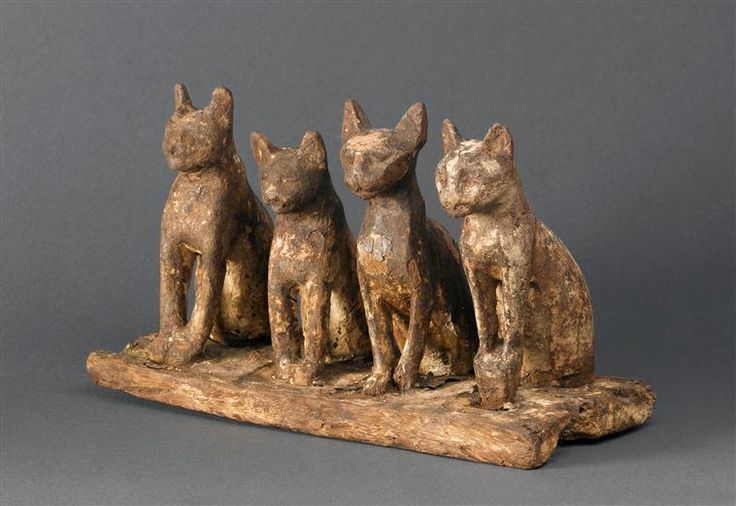Bastet, also known as Bast, was an ancient Egyptian goddess who originally had the role of protecting the Pharaohs. The inhabitants of the lower Nile depicted Bastet as a savage, lion-headed deity. After 1000 BCE, the Egyptians altered her image to the body of a woman and the head of a domesticated cat. Along with her change in appearance, she was also transformed into a peaceful and approachable deity. Instead of Bastet protecting Pharaohs, she was now a nurturer and protector of all households. Families soon began to invite cats inside their homes, thinking that they brought with them the spirit of Bastet. They worshiped these cats because they also hunted mice, snakes, and other pests that ruined their crops and their perishable goods. Bastet’s role as a goddess was further altered when she acquired the trait of fertility. Women would purchase pendants with Bastet and multiple kittens to enhance their fertility.1

Statues and depictions of Bastet vary. She transforms from a beast with a female lion’s head, to a woman with the head of a cat, to a regular black cat with kittens who sometimes held a rattle. Some thought the rattle was actually a musical instrument called a sistrum. Because of this, Bastet was also associated with music and dance. Soon after the sistrum was added to Bastet’s image, the Egyptians used the instrument at festivals where they would worship Bastet. Then, Bastet was depicted wearing a decorative dress, carrying the sistrum in her right hand and a shield in her left, with a bag over her arm.2
The Egyptians had an explanation for why she was transformed from a savage beast to a fertility and music goddess. Bastet was the daughter of Ra, the sun god who was vengeful. From him she got her aggressiveness. Her mother is unknown, but the Egyptians suspect that Ra sent young Bastet to Nubia as a lioness in isolation. There she was able to let out her rage, and then wander back to Egypt as a docile cat. Later an unknown king proclaimed that Bastet was his mother. Egyptian women then believed worshiping her would provide them with many children, as house cats would typically have up to twelve kittens; and one of her sons became king. Experts believe that the baby rattle was mistakenly interpreted as a sistrum, which led to her being known as a music and dance goddess.3

In depictions of wars on the walls of palaces, she was portrayed as a lion, and in homes she was a cat. Although Bastet was a goddess with many traits, that was not all that uncommon. In ancient Egypt gods and goddesses often served more than one purpose. Along with her most common traits, she was also thought of as the goddess of the sun, which she inherited from her father, as well as the goddess of physical pleasure. It was even believed that if a cat ran through a fire, the fire would be put out; therefore, she became the deity of firefighters.4
It is undeniable that Bastet was highly respected. Experts are still unable to determine when Egyptians first began to worship her as well as when her presence faded. Many statues of Bastet and mummified cats have been discovered along the lower Nile, which has led experts to believe that festivals were held there in her honor and locals worshiped her to the highest degree. Although she did have many roles, she is best known as the goddess of protection.5
“His totem animal in black onyx
erect on her haunches poised and aware
he brings in a dream that I might learn
cats are cats and gods—slit-eyed in the sun
in darkness with dilated iris she sees
protector I hope though at times in the night
I tense at her wild amorous cry…”
–Bastet 6
- The Salem Press Encyclopedia, 2o16, s.v. “Bastet (diety),” by Latha Iyer. ↵
- Kathryn Razavi, “The Lioness and the Kittycat: Egypt’s Great Feline Goddess” (Undergraduate Honors Thesis, University of Colorado, 2013), 20-25. ↵
- Nora Scott, “The Cat of Bastet,” The Metropolitan Museum of Art Bulletin, 1 (1958): 1. ↵
- Kathryn Razavi, “The Lioness and the Kittycat: Egypt’s Great Feline Goddess” (Undergraduate Honors Thesis, University of Colorado, 2013), 23. ↵
- Salem Press Encyclopedia, 2o16, s.v. “Bastet (diety),” by Latha Iyer. ↵
- Phyllis Stowell, “Bastet,” Psychological Perspectives 56, no. 3 (2013): 362-364. ↵



67 comments
Noah Bolhuis
It has always confused me as to why cats were seen as deity figures in ancient Egypt. In my experience, cats have been lazy and all about themselves, making them as far from something I could worship at all. However, it was nice to read about how and why these ancient people did worship cats. It was also interesting to read about how the god transitioned from a beast at a regular cat.
Bonnie S Shirley
They began as mice and rodent catchers for early farmers, possibly 10,000 years ago in the Near East. As humans learned to store grain, they began to attract rodents. Cats are also excellent small poisonous snake killers, and scorpion killers. Cats are lazy because they no longer have jobs to do in modern cultures; that is due to human behavior, not cats…:).
Victoria Rodriguez
I am not very familiar with the Basket. I am interested in Egyptian art because it is so intriguing to know the meaning behind all the different facets of the Egyptian art form. I think the Egyptians were unique in the sense of their as well. Some art was used in their everyday life and I think in tat sense that is a whole separate art form. I enjoyed the images in your article and enjoyed the details given.
Bonnie S Shirley
Bastet, rather than baskek. A nice article.
Maisie Favila
I love Egyptian art because it’s so interesting. Although I had never heard of Bastet, I am glad I read this article. I didn’t know that this goddess and her story would be so intriguing. This article really described her and the evolution of her very clearly, leaving me curious about even more information on her. I think it’s so interesting that these people worshiped these figures of cats for the hope of the goddess providing. Overall, this article was very well written and interesting.
Belene Cuellar
This is such an interesting story about a goddess I had never even heard of in the first place. Baset has so many versions of herself, but one thing remains consistent, she is a powerful goddess. Wheter it be as a fertility goddess or a giant lioness she always radiates grace and power. It’s kind of interesting how people make different perceptions of a goddess to fit their way of life.
Lilliana Canales
This article was very interesting, and from the description of her appearance, it made me wonder if this is where the artists for Wonder Woman’s comics got the idea of Cheetah, although she isn’t a lioness. I’ve never heard of Bastet until now, but from this article, it is very self explanatory why cats were worshiped in the ancient world of Egypt.
Kathyleen Lauriano
This article was very interesting to read about. Anything with gods and goddesses is extremely intriguing. Its really captivating that the Egyptians believed in these creatures. I had never known about Bastet until reading this article. This article did good in describing Bastet and the evolution of her. Its nice to read about how she changed through time and influenced their society. This article was well written. Great job!
Annissa Noblejas
Bastet is an ever-evolving Egyptian goddess. The stories from a savage lion-headed beast protecting pharaohs, to a domestic cat-headed woman overseeing crops and families flourish. Eventually Bastet officially adopts the role of enhancing fertility. She seems to adapt to her stories depending on what her usefulness would be in different scenarios. I’m curious if the practice of mummified cats was an embodiment of her continued protection in the afterlife.
Esperanza Rojas
It was really interesting to read about a goddess that was worshiped for many reasons. The topic of Egyptians gods aren’t as a known topic as Greek gods, but learning about this one made me more interested in learning about the others. Its was also weird to hear about the Egyptians perception of cats, and how they were greatly worshiped, whereas in modern times, it is the opposite. We are scared of black cats for we believe they would bring bad luck and the Egyptian culture it was a good luck for a variety of things.
Valeria Perez
I usually don’t hear much about Egyptian gods, but I will look into it some more after this article.
It is interesting to see how Bastet’s traits changed according to what people needed at the time. From a goddess of fertility to the deity of firefighters. She really did it all! I also really enjoyed her transition from the pharaoh’s protector to the protector of all the people.
Anna Guaderrama
I had never heard about Bastet so I loved reading this article because I found it very informational. It’s interesting how the Egyptians altered her image form a savage to the image of a female body and the head of a domesticated cat and a peaceful and approachable deity. People really worshipped cats in hopes that this goddess would enhance fertility. But its also amusing how they welcomed cats regardless because of the services they provide.